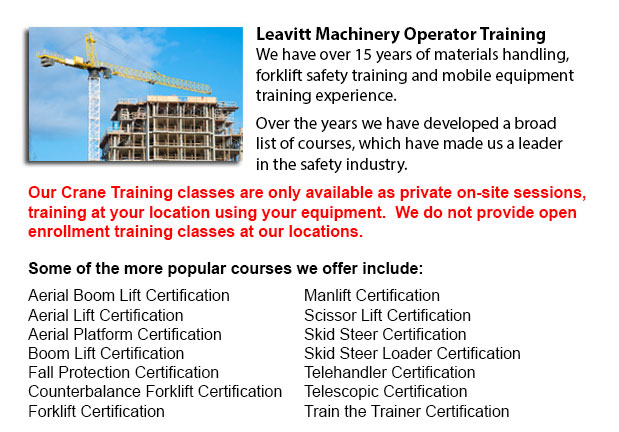
Overhead Crane Operator Training Prince Albert - Our overhead crane operator training program is meant to teach workers the basics of overhead crane/sling operation and pre-shift inspections. Courses are taught by our professional trainers and consultants. Well-trained employees are more efficient and productive, that saves on expenses associated with product damage, property damage, and accidents because of the utilization of incorrect operating procedures. Our overhead crane certification is customized for workers who have literacy barriers, reducing certification time by 50 percent.
Overhead cranes are best for specific repetitive hoisting activities. This kind of crane has wide ranging capacities. They could be utilized for specialized hoisting jobs like for example removing or installing major plant machines.
To safely use an overhead crane, staff must employ safe rigging practices. This requires both knowledge and practice. The load must be rigged properly to guarantee its stability when lifted. Prior to beginning a hoisting job, it must be determined that the crane is suitable for the task, with appropriate capacity, travel and lift. The crane should be subjected to a thorough visual and physical check before use. The capacity of all machinery, including the hardware, rope and slings, should never go over load weight capacities.
Before utilizing the rigger should know which sling is best for each and every lift and must inspect the rigging gear and hardware. The communications which are utilized with the crane operator need to be concise and clear. A signaler must be designated for the role and signals have to be agreed upon. The crane operator has to follow instructions just from the designated individual. If a remote or wired controller is being utilized, the operator should be trained in all its functions.
To be able to ensure the safety of workers, a warning needs to be issued and the path of the load should be cleared of all obstacles before the lift begins. People must not be allowed to walk underneath the lift loads. The crane hoist must be centered over the load prior to hoisting to prevent swinging. The safety catch has to be closed instantly after sliding the sling entirely onto the lifting hook. Sling legs that are not utilized should be secured so they do not drag. Never leave loose materials on a load being hoisted. Watch that fingers and hands are clear when slack is taken out of a sling. Before the lift is carried out, step clear of the danger zone.
-
Zoom Boom Training Prince Albert
Zoom Boom Training Prince Albert - Zoom Boom Training focuses on correctly training potential operators on variable reach forklifts. The training objectives include gaining the understanding of the machine's physics and to be able to define the job o... More -
Bucket Truck Training Prince Albert
Bucket Truck Training Prince Albert - The Vehicle-Mounted Aerial Work Platform or also called bucket truck training program is intended to reduce the chance of incident and personal injury when working with or in close proximity to bucket trucks by e... More -
Aerial Lift Training Prince Albert
Aerial Lift Training Prince Albert - An aerial work platform is a mechanized access platform. This device provides access to otherwise not accessible places for people or equipment. Likewise called an aerial device or elevating work platform, the mac... More -
Overhead Crane Ticket Prince Albert
Overhead Crane Ticket Prince Albert - The overhead crane is a common heavy machinery utilized in industrial settings. This particular machine is known as a bridge crane and comprises parallel runways spanned by a traveling bridge. The hoist is the co... More -
Scissor Lift Ticket Prince Albert
Scissor Lift Ticket Prince Albert - Scissor lifts have greatly benefited construction operations because the task that used to need a lot of effort and lots of people, can now be accomplished using the scissor lift and just one individual, the operat... More -
Manlift Training Prince Albert
Manlift Training Prince Albert - Different manlift training programs include the review and content of manlift devices. An essential part of the program is the practicum where students demonstrate their knowledge and practical ability to operate the... More -
Skid Steer Loader Training in Prince Albert
The engine powered skid-steer loader consists of a rigid and small frame, equipped along with lift arms which could attach to various industrial attachments and tools to be able to perform various labor saving tasks. Normally, skid-steer loaders are... More -
Crane Training School Prince Albert
Crane Training School Prince Albert - We provide industry relevant programs in our crane training school. The course will provide our trainees with learning outcomes matching the existing industry demands. Our small class sizes combine theory and han... More

Forklift Training Prince Albert
TOLL FREE: 1-888-254-6157
Prince Albert, Saskatchewan
forklifttrainingprincealbert.com
Email Us
About Us


